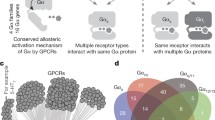Abstract
G-protein-coupled receptors have recently been identified at the single molecule level using fluorescent labels attached either to receptors themselves or to their ligands. These studies have revealed a significant heterogeneity of receptors in terms of localization, mobility, and aggregation state (mono-, di- and oligomers). The consequences of this heterogeneity are still largely unknown, but first data suggest that it may result in distinct functions.
Similar content being viewed by others
Literatur
Schwabe U, Paffrath D (2012) Arzneiverordnungsreport 2012. Springer Medizin Verlag, Berlin, Heidelberg
Rask-Andersen M, Almén MS, Schiöth HB (2011) Trends in the exploitation of novel drug targets. Nat Rev Drug Discov 10:579–590
Ghosh RN, Webb WW (1994) Automated detection and tracking of individual and clustered cell surface low density lipoprotein receptor molecules. Biophys J 66:1301–1318
Kusumi A, Sako Y, Yamamoto M (1993) Confined lateral diffusion of membrane receptors as studied by single particle tracking (nanovid microscopy). Effects of calcium-induced differentiation in cultured epithelial cells. Biophys J 65:2021–2040
Hern JA, Baig AH, Mashanov GI et al. (2010) Formation and dissociation of M1 muscarinic receptor dimers seen by total internal reflection fluorescence imaging of single molecules. Proc Natl Acad Sci USA 107:2693–2698
Nenasheva TA, Neary M, Mashanov GI et al. (2013) Abundance, distribution, mobility and oligomeric state of M2 muscarinic acetylcholine receptors in live cardiac muscle. J Mol Cell Cardiol 57:129–136
Kasai RS, Suzuki KG, Prossnitz ER et al. (2011) Full characterization of GPCR monomer-dimer dynamic equilibrium by single molecule imaging. J Cell Biol 192:463–480
Pin JP, Neubig R, Bouvier M et al. (2007) International Union of Basic and Clinical Pharmacology. LXVII. Recommendations for the recognition and nomenclature of G protein-coupled receptor heteromultimers. Pharmacol Rev 59:5–13
Snaar-Jagalska BE, Cambi A, Schmidt T et al. (2013) Single-molecule imaging technique to study the dynamic regulation of GPCR function at the plasma membrane. Methods Enzymol 521:47–67
Calebiro D, Rieken F, Wagner J et al. (2013) Single-molecule analysis of fluorescently labeled GPCRs reveals receptorspecific complexes with distinct dynamics and organization. Proc Natl Acad Sci USA 110:743–748
Nikolaev VO, Moshkov A, Lyon AR et al. (2010) β2-Adrenergic receptor redistribution in heart failure changes cAMP compartmentation. Science 327:1653–1657
Lohse MJ, Calebiro D (2013) Receptor signals come in waves. Nature 495:457–458
Author information
Authors and Affiliations
Corresponding author
Additional information
Martin J. Lohse Medizinstudium an den Universitäten Göttingen, London und Paris. 1981 Promotion. 1988 Habilitation für das Fach Pharmakologie und Toxikologie an der Universität Heidelberg. 1988-1990 Research Assistant und Assistant Professor bei Prof. Dr. R. J. Lefkowitz, Howard Hughes Medical Institute (HHMI), Duke University, Durham, NC, USA. 1990–1993 Gruppenleiter am Max-Planck-Institut für Biochemie, Martinsried. Seit 1993 Professor und Leiter des Instituts für Pharmakologie und Toxikologie der Universität Würzburg. Seit 2001 Leitung des Rudolf-Virchow-Zentrums für experimentelle Bio medizin an der Universität Würzburg.
Carsten Hoffmann Jahrgang 1967. Chemiestudium an der Universität Bremen. 1996 Promotion. 1997–2000 Postdoc, National Institutes of Health, Bethesda, MD, USA. 2000–2003 Postdoc und 2004–2012 Arbeitsgruppenleiter am Institut für Pharmakologie und Toxikologie der Universität Würzburg. 2011 Habilitation für das Fach Pharmakologie und Toxikologie an der Universität Würzburg. Seit 2012 Professor am Bioimaging-Center/Rudolf-Virchow-Zentrum und Institut für Pharmakologie und Toxikologie der Universität Würzburg.
Davide Calebiro Jahrgang 1975, Medizinstudium, PhD (Molekulare Medizin) und Facharztausbildung (Endokrinologie), Universität Mailand, Italien. 2007–2008 Humboldt-Stipendiat Pharmakologie, Universität Würzburg, 2008–2009 Postdoc und Arzt, Experimentelle Endokrinologie, Universität Mailand; seit 2009 wissenschaftlicher Mitarbeiter und AG-Leiter, Bioimaging-Zentrum/Rudolf-Virchow-Zentrum der Universität Würzburg.
Rights and permissions
About this article
Cite this article
Lohse, M.J., Hoffmann, C. & Calebiro, D. GPCRs — einzelnen Rezeptoren auf der Spur. Biospektrum 19, 600–604 (2013). https://doi.org/10.1007/s12268-013-0358-1
Published:
Issue Date:
DOI: https://doi.org/10.1007/s12268-013-0358-1




